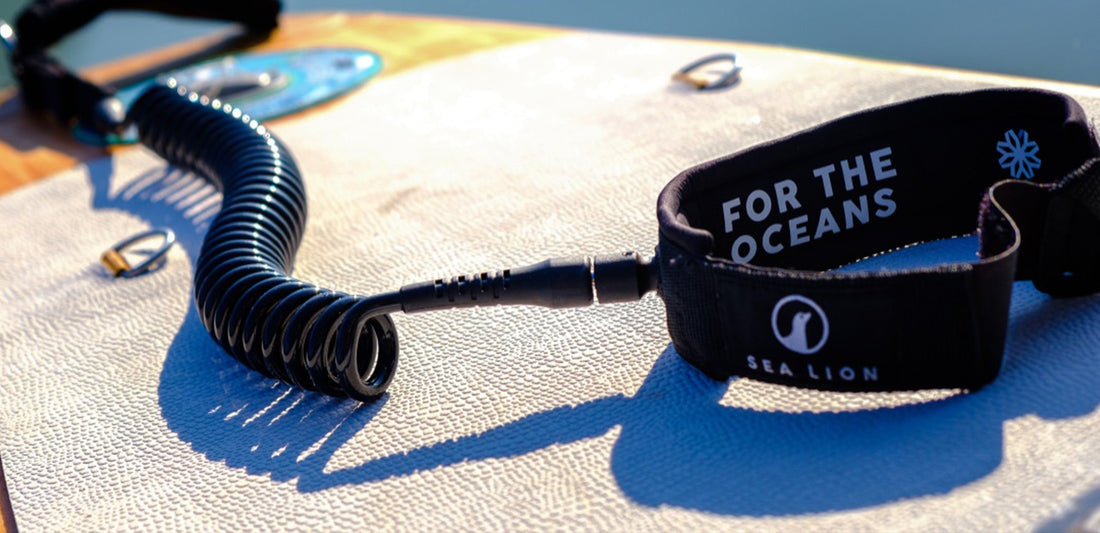When it comes to Stand Up Paddleboarding, leashes are an essential part of your kit and not one to be overlooked, so it’s worth taking the time to familiarise yourself with the different types so you know which one would be best suited to your paddling discipline and environment.
There are two different types of SUP leash, which can be worn in 3 ways, so let’s take a look at the differences and which one would be best for you!
Straight SUP leash
A straight SUP leash is exactly that. It’s a straight leash, which is usually around 10ft in length. These are predominately used in surfing so that during a wipe out the board is kept at a safe distance and doesn’t ‘coil’ back and hit you.
Cons:
- Drag – A straight leash is long! It will drag behind your board and cause drag which can affect your paddle efficiency and slow you down.
- Tangled Up – With all the slack and length, eventually it will tangle and not only be annoying to keep untangling but also becomes a safety concern if you were to fall off.
- Get Caught – Not only will it tangle itself, but you’ll potentially find yourself getting caught on objects in shallow water with a straight leash.
Coiled SUP leash
A coiled leash will look similar to a spring. The length of the leash will be naturally coiled but can extend when pulled. This eliminates the slack that would be associated with a straight leash. No slack means no drag, which in turns means you’re less likely to get tangled or snagged on anything in shallow water.
Cons:
- Springy – If used for SUP surfing (which isn’t really recommended) it could cause the board to spring back and hit you after a wipe out… Not ideal!
Now that we know the pros and cons to either Straight or Coiled leashes, let’s take a look at how you can wear them and why:
Ankle
You’ll find this the most common type of leash sold with SUPs, however not the best for all bodies of water and situations. It is only suitable for lakes, canals, sea/coastal areas, surf, and slow-moving deep water. Therefore, in fast flowing water/river situation, an ankle leash should not be used.
They are easy to wear and should be worn on the ankle of your most dominate foot (if you skateboard or surf, this would be the foot you always have at the back of your board).
Calf
The most popular type of leash used in SUP racing is the calf leash. This keeps it from dragging and prevents the chance for it to get caught around your ankle when you step back on a buoy turn. Can be used in similar environments as ankle leashes, such as for lakes, canals, sea/coastal areas, surf, and slow-moving deep water. The main difference here is that the cuff attachment is slightly larger and designed to be fitted just below you knee instead of around the ankle.
Quick release (qr) waist
These should be used on moving/flowing water including rivers, tidal rivers and estuaries, white water rivers and anywhere there are potential entanglement risks. A lot of “waist leashes” are actually belts that you attached an ankle leash onto. ALL waist leashes should be quick release as it can then be easily reached and released if you were to come off your board and get caught or held under by the force of the moving water around you.
Example Situation: if you are on a flowing body of water like a river that has pontoons, boat moorings etc, if you were to fall off and find yourself getting entangled round a boat mooring you can quickly release yourself from your board via your waist quick release buckle. If you were to wear an ankle leash in the same situation, you will unlikely be able to release yourself from your ankle because of the weight of the water and therefore putting yourself in danger.
If you are unsure on what type of leash you should wear before you get on the water, make sure you educate yourself as this could save your life!
Quick test - answer these questions to see if you know which leash type is best!
- What leash should you wear in surf? - Straight ankle leash
- What leash should you wear on a flowing river? - A quick release waist leash
- What leash should you wear on a lake? - A waist leash or ankle leash. The environment and weather should determine what you type you should use!
- When should I wear a leash? - ALWAYS. Never get on the water without a leash, it could save your life. If you do not have the right leash for the right environment, do not go out.
Remember ~ The right leash will save your life
If you’ve enjoyed reading this blog, then you can check out more of our safety advice here, such as our Wind and Tides basics and don’t forget you can also follow us across our social media channels where you’ll find lots more information and advice on our products and all things paddleboarding!




